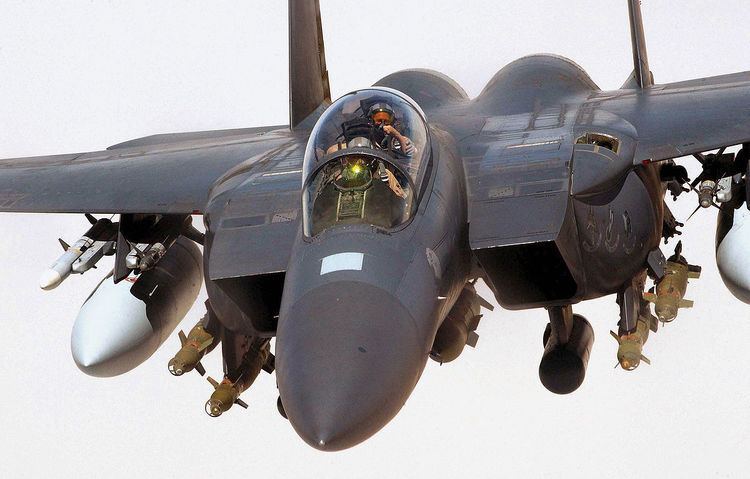Conformal fuel tanks (CFTs) are additional fuel tanks fitted closely to the profile of an aircraft that extend either the range or "time on station" of the aircraft. CFTs have a reduced aerodynamic penalty compared to external drop tanks, and do not significantly increase an aircraft's radar cross-section. Another advantage of CFTs provide is that they do not occupy ordnance hardpoints like drop tanks, allowing the aircraft to carry its full payload.
Conformal fuel tanks have the disadvantage that, unlike drop tanks, they cannot be discarded in flight, because they are plumbed into the aircraft and so can only be removed on the ground. As a result, they will impose a slight drag-penalty and minor weight gain on the aircraft even when the tanks are empty, without any benefit. They can also impose g-load limits, although not always an absolute issue, the CFTs on the F-15E actually allow the same maneuverability without g-limitations.
F-15C Eagle/F-15E Strike EagleF-15C entered service with CFT capability. Initially known as FAST packs (Fuel And Sensor Tactical), each unit carried an additional 849 US gallons (3,213.8 L) of fuel, while retaining hardpoints for four AIM-7F Sparrow missiles or bombs, some on the FAST packs. They were first tested on the F-15B in 1974. All U.S. F-15Es, and Strike Eagle export variants such as the Israeli and Singapore models, are fitted with CFTs under the wing outside the engine intake and require modification to fly without them. The FAST pack was originally intended to carry a navigational and targeting infrared sensor system (thus "Fuel And Sensor"); however, the F-15 simply began carrying
LANTIRN pods for ground-attack missions instead.
F-16C/D Block 50/52+, F-16E/F Block 60 and F-16I SufaExport aircraft for Greece, Chile, Israel, Poland, Pakistan, Turkey, Singapore, Morocco, Egypt and the UAE are plumbed for carriage of two CFTs mounted on top of the aircraft near the wing root. Each is capable of holding 450 US gallons (1,703.4 L)
Dassault RafaleTwo 1,150 litres (300 US gal) CFTs were first tested by
Dassault in April 2001.
Eurofighter TyphoonWind tunnel tested by BAE, two CFTs with 1,500 litres (400 US gal) capacity.
AIDC F-CK-1 Ching-kuoThe F-CK-1D prototype ("Brave Hawk") and the F-CK-1C single-seater prototype are equipped with the new CFTs. The prototype Indigenous Defence Fighter II “Goshawk” has over-wing CFTs.
Advanced Super HornetConformal fuel tanks are mounted above the wings to replace the drag of underwing tanks. Combined, they carry 3,500 lb of extra fuel, while adding extra lift and expanding combat radius by 260 nmi with a small transonic acceleration penalty.
Chengdu J-10Wind Tunnel tested by
Chengdu.
BAC StrikemasterConformal fuel tanks were installed on the wingtips.
WWII:Supermarine Spitfire in the belly.Messerschmitt Bf 109 in the belly.Messerschmitt Bf 110D-1 in the belly - nicknamed Dackelbauch (dachshund's belly).Distended internal tanks are fuel tanks that create a bulge from the fuselage or are mounted flush with the fuselage.
English Electric Lightning Conformal ventral store was used for a small or large belly fuel tank which bulges out from the underbodyGloster Javelin fitted with dual flush-mounted belly tanks with a capacity of 1,137 liters (300 US gallons). They were known as "bosom tanks" or "Sabrinas"Gloster MeteorShenyang J-6Nanchang Q-5 "Fantan" weapons bay fuel tank extends below the fuselage profile 
